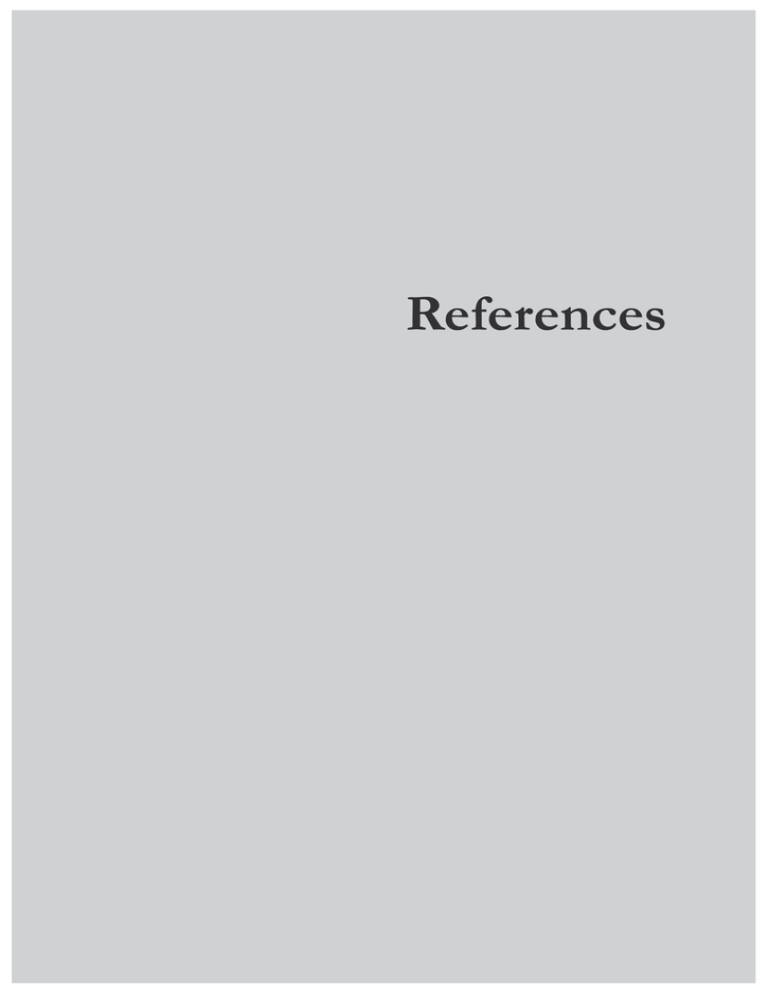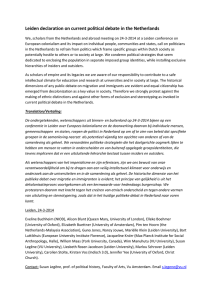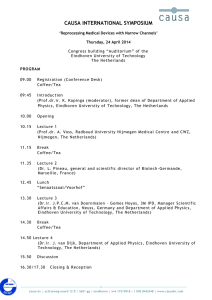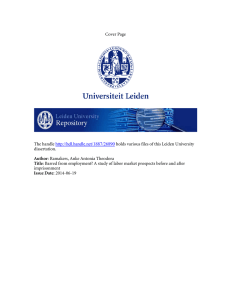References - VU
advertisement

References References Aarten, P. G. M., Denkers, A., Borger, M. J., & Van Der Laan, P. H. (2013). Reconviction rates after suspended sentences: Comparison of the effects of different types of suspended sentences on reconviction in the Netherlands . DOI: 10.1177/0306624X13508929 Abraham, M., Van Dijk, B., & Zwaan, M. (2007). Inzicht in toezicht: De uitvoering van toezicht door de reclassering. Amsterdam, the Netherlands: DSP groep, WODC. Achterberg, P. (2006). Het einde van links en rechts: realiteit of populaire mythe. , 51-63. Ackerman, S. J., & Hilsenroth, M. J. (2003). A review of therapist characteristics and techniques positively impacting the therapeutic alliance. (1), 1-33. Aiken, L. S., & West, S. G. (1991). Multiple regression: Testing and interpreting interactions. Thousand Oaks, California: Sage Publications. Andrews, D. A., & Bonta, J. (2010). . Newark, NJ: LexisNexis. rehabilitation: Rediscovering psychology. 52. (1), 19- correctional treatment: A meta-analytic investigation. International Journal of (1), 88-100. Andrews, D. A., & Kiessling, J. J. (1980). Program structure and effective correctional practices: A summary of the CaVic research. In R. R. Ross & P. Gendreau (Eds.), Effective correctional treatment (pp. 441-463). Toronto, Canada: Butterworths. Andrews, D. A., Zinger, I., Hoge, R. D., Bonta, J., Gendreau, P., & Cullen, F. T. (1990b). Does correctional treatment work? A clinically relevant and psychologically informed meta-analysis. , 369-404. Antonowicz, D. H., & Ross, R. R. (1994). Essential components of successful rehabilitation programs for offenders. (2), 97-104. Aos, S., Miller, M., & Drake, E. (2006). Evidence-based adult corrections programs: What works and what does not. Olympia: Washington State Institute of Public Policy. Applegate, B. K., Cullen, F. T., & Fisher, B. (1997). Public support for correctional treatment: The continuing appeal of the rehabilitative ideal. The Prison Journal, (3), 237-258. Armstrong, S., McIvor, G., McNeill, F., & McGuiness, P. (2013). International evidence review of conditional (suspended) sentences. Final report. Glasgow, UK: The Scottish Centre for Crime & Justice Research. 151 References Bagaric, M. (1999). Suspended sentences and preventive sentences: Illusory evils and disproportionate punishments. 22, 535-563. Barber, J., & Doob, A. N. (2004). An analysis of public support for severity and proportionality in the sentencing of youthful offenders. Canadian Journal of (3), 327-342. Barber, J. P., Luborsky, L., Crits-Christoph, P., Thase, M. E., Weiss, R., Frank, A., Onken, L., & Gallop, R. (1999). Therapeutic alliance as a predictor of outcome in treatment of cocaine dependence. (1), 54-73. Barnes, G. C., Ahlman, L., Gill, C., Sherman, W., Kurtz, E., & Malvestuto, R. (2010). Low-intensity community supervision for low-risk offenders: a randomized, controlled trial. (2), 159-189. Baron, R. M., & Kenny, D. A. (1986). The moderator-mediator variable distinction in social psychological research: Conceptual, strategic, and statistical considerations. (6), 1173-1182. Bartels, L. (2007). The use of suspended sentences in Australia: Unsheathing the sword of Damocles. , 113-132. Bartels, L. (2009). The weight of the sword of Damocles: A reconviction analysis of suspended sentences in Tasmania. Australian & New Zealand Journal of (1), 72-100. Becker, H. S. (1963). . New York: Free Press. Becker, S. O., & Caliendo, M. (2007). Sensitivity analysis for average treatment effects. (1), 71-83. Beerthuizen, M. G. C. J., & Wartna, B. S. J. (2013). Vrijheid binnen de perken. Een verkennend onderzoek naar de inzet van voorwaardelijke vrijheidsstraffen. The Hague, the Netherlands: WODC. Bernburg, J. G. (2009). Labelling theory. In M. D. Krohn, A. J. Lizotte & G. P. Hall (Eds.), Handbook on crime and deviance (pp. 187-207). London: Springer. Bies, R. J., & Moag, J. S. (1986). Interactional justice: communication criteria of fairness. In R. J. Lewicki, B. H. Sheppard & M. H. Bazerman (Eds.), Research on negotation in organizations (pp. 43-55). Greenwich, CT: JAI Press. Bleichrodt, E. (1996). Onder voorwaarde: een onderzoek naar de voorwaardelijke veroordeling en andere voorwaardelijke modaliteiten. Deventer, the Netherlands: Gouda Quint. Bleichrodt, E. (2000). Creativiteit en voorwaardelijke sanctionering. Justitiële Verkenningen, 26(4), 44-51. Bleichrodt, E. (2009). De herontdekking van de bijzondere voorwaarde. Proces, (6), 304-313. Bleichrodt, F. W., & Vegter, P. C. (2013). Sanctierecht. Deventer, the Netherlands: Kluwer. 152 References Blumstein, A., Cohen, J., & Nagin, D. S. (1978). Deterrence and incapacitation: Estimating the effects of criminal sanctions on crime rates. Washington, D.C.: National Academy of Sciences. Bonta, J., & Andrews, D. A. (2007). and rehabilitation. Ottawa: Public Safety Canada. Bonta, J., Bourgon, G., Rugge, T., Scott, T. L., Yessine, A. K., Gutierrez, L., & in evidence-based community supervision. (11), 1127-1148. Bonta, J., Rugge, T., Scott, T. L., Bourgon, G., & Yessine, A. K. (2008). Exploring the black box of community supervision. (3), 248-270. Boone, M. (2010). Only for minor offences: Community service in the Netherlands. European Journal of Probation, 2(1), 22-40. Boone, M., & Moerings, M. (2007). Growing Prison Rates. In M. Boone & M. Moerings (Eds.), Dutch Prisons (pp. 51-76). The Hague, the Netherlands: BJu Legal Publishers. Bordin, E. S. (1979). The generalizability of the psychoanalytic concept of the working alliance. (3), 252-260. Bottoms, A. E. (1995). The philosophy and politics of punishment and sentencing. In C. M. V. Clarkson & R. Morgan (Eds.), The politics of sentencing reform (pp. 1750). Oxford: Clarendon. Bottoms, A. E. (2001). Compliance with community penalties. In A. Bottoms, L. Gelsthorpe & S. Rex (Eds.), (pp. 87116). Cullompton: Willan. Bourgon, G., Bonta, J., Rugge, T., Scott, T., & Yessine, A. K. (2010). The role of program design, implementation and evaluation in evidence-based “real world” community supervision. (1), 2-15. in criminal justice: A review of the British research literature. In A. Jokinen, E. Ruuskanen, M. Yordanova, D. Markov & M. Ilcheva (Eds.), Review of need: for the Study of Democracy. Brody, S. R. (1976). The effectiveness of sentencing - a review of the literature. London: Her Brouwers, M., & Eggen, A. T. J. (2012). Berechting. In S. N. Kalidien, N. E. De Heer-De Lange & M. M. Van Rosmalen (Eds.), Criminaliteit en Rechtshandhaving 2012: Ontwikkelingen en samenhangen (pp. 133-152). Meppel, the Netherlands: Boom Juridische Uitgevers. 153 References assisting offenders to desist from crime. (3), 247-268. Casper, J. D., Tyler, T., & Fisher, B. (1988). Procedural justice in felony cases. Law (3), 483-507. CentERdata. (2013). Longitudinal Internet Studies for the Social sciences (LISS) panel. Tilburg University, the Netherlands Chung, C., Schmidt, P., & Witte, A. D. (1991). Survival analysis: A survey. Journal of (1), 59-98. Cid, J. (2005). Suspended sentences in Spain: Decarceration and recidivism. (2), 169-179. Cid, J. (2009). Is imprisonment criminogenic? A comparative study of recidivism rates between prison and suspended prison sanctions. European Journal of (6), 459-480. Clarke, S. H., Lin, Y. W., & Wallace, W. L. (1988). Probationer recidivism in North (Vol. University of North Carolina at Chapel Hill School of Government): Chapel Hill, NC. Cocker, S. (2006). West Yorkshire. West Yorkshire: National Probation Service. Commissie Vrijheidsbeperking. (2003). Vrijheidsbepekring door voorwaarden. De voorwaardelijke veroordeling en haar samenhang met de taakstraf, de voorlopige hechtenis en de voorwaardelijke invrijheidsstelling. The Hague, the Netherlands: Sdu. Cox, D. R. (1972). Regression models and life-tables. (2), 187-220. Cullen, F. T., Fisher, B. S., & Applegate, B. K. (2000). Public opinion about punishment and corrections. , 1-79. De Keijser, J. W. (2000). action. Amsterdam, the Netherlands: Thela Thesis. De Keijser, J. W., & Elffers, H. (2009). Punitive public attitudes: A threat to the legitimacy of the criminal justice system? In M. E. Oswald, S. Bieneck & J. Hupfeld-Heinemann (Eds.), (pp. 55-74). UK: Wiley-Blackwell. De Koster, W., Van Der Waal, J., Achterberg, P., & Houtman, D. (2008). The rise of the penal state. Neo-liberalization or new political culture? British Journal of (6), 720-734. Dekker, P., & Van Der Meer, T. (2007). Vertrouwen in de rechtspraak nader onderzocht. The Hague, the Netherlands: Sociaal en Cultureel Planbureau. Dignan, J. (1984). The sword of Damocles and the clang of the prison gates: Prospects on the inception of the partly suspended sentence. The Howard (3), 183-200. 154 References DiPrete, T. A., & Gangl, M. (2004). Assessing bias in the estimation of causal effects: Rosenbaum bounds on matching estimators and instrumental variables estimation with imperfect instruments. (1), 271-310. Directoraat-Generaal Preventie Jeugd en Sancties. (2008). Maatregelen recidivireductie: nadruk op nazorg. The Hague, the Netherlands: Ministerie van Veiligheid en Justitie. Dirkzwager, A., Nieuwbeerta, P., & Fiselier, J. P. S. (2009). Onbedoelde gevolgen van vrijheidsstraffen: Een literatuurstudie. (1), 2141. Dowden, C., & Andrews, D. A. (2004). The importance of staff practice in delivering effective correctional treatment: a meta-analytic review of Core Correctional Practice. (2), 203-214. Downes, D., & Van Swaaningen, R. (2007). The road to Dystopia? Changes in the penal climate of the Netherlands. , 3171. Durham, A. M. (1993). Public opinion regarding sentences for crime: Does it exist? Journal of Criminal Justice, 21(1), 1-11. Durnescu, I. (2012). What matters most in probation supervision: Staff characteristics, staff skills or programme? (2), 193-216. Misdrijven: Opgelegde straffen en maatregelen. Retrieved 31 January 2014, from http://statline.cbs.nl/StatWeb/pub lication/?DM=SLNL&PA=03727&D1=4-6&D2=0&D3=0&D4=0&D5=(l10)-l&VW=T. Elffers, H., & De Keijser, J. W. (2008). Different perspectives, different gaps: Does the general public demand a more responsive judge? In H. Kury (Ed.), Fear of (pp. 447-470). Bochum: Universitätsverlag Dr. N. Brockmeyer. Elffers, H., De Keijser, J. W., Van Koppen, P. J., & Van Haeringen, L. (2007). attitudes towards the criminal justice system. , 163-182. Farrington, D. P. (1983). Randomized experiments on crime and justice. Crime and Justice, 4, 257-308. Farrington, D. P., & Welsh, B. C. (2006). A half century of randomized experiments on crime and justice. , 55-132. Faulkner, D. (2005). Parties, politics and punishment. Criminal Justice Matters, 60(1), 6-39. 155 References Flanagan, J. T. (1996). Community corrections in the public mind. Federal Probation, 60(3), 3-9. Flight, S., Nauta, O., Terpstra, J., De Jonge, G., Hulshof, P., Abraham, M., & Roorda, W. (2011). Voorwaardelijk vrij: Evaluatie van de wet voorwaardelijke invrijheidsstelling. The Hague, the Netherlands: WODC. Franke, H. (1996). Twee eeuwen gevangenisstraf in Nederland. De macht van het lijden. The Netherlands: Balans. Freiberg, A., & Moore, V. (2009). Disbelieving suspense: Suspended sentences of Australian (1), 101-122. Friendship, C., Beech, A. R., & Browne, K. D. (2002). Reconviction as an outcome measure in research: A methodological note. , 442-444. Frigo, D. (2006). Therapeutic alliance: Improving treatment outcome. Minnesota: Butler Center for Research, Hazelden Foundation. American (5), 420-424. Gaston, L. (1990). The concept of the alliance and its role in psychotherapy: Theoretical and empirical considerations. (2), 143-153. Gaston, L., Marmer, C. R., Gallagher, D., & Thompson, L. W. (1991). Alliance prediction of outcome beyond in-treatment symptomatic change as psychotherapy processes. (2), 104-113. Geerken, M., & Gove, W. R. (1975). Deterrence: Some theoretical considerations. (3), 497-513. Gendreau, P., & Ross, R. R. (1981). Correctional potency: Treatment and deterrence on trial. In R. Roesch & R. R. Corrado (Eds.), . Beverly Hills, CA: Sage Publications. Glaze, L. E., Bonczar, T. P., & Zhang, F. (2010). Probation and parole in the United States 2009 (BJS Special Bulletin NCJ 2231674). Washington, DC: U.S. Department of Justice. Gray, M. K., Fields, M., & Maxwell, S. R. (2001). Examining probation violations who, what and when. (4), 537-557. Guo, S., & Fraser, M. W. (2010). applications. Thousands Oaks: SAGE Publications. Henderson, H., Wells, W., Maguire, E. R., & Gray, J. (2010). Evaluating the measurement properties of procedural justice in a correctional setting. Criminal (4), 384-399. Hirschi, T. (1969). . Berkeley: University of California Press. 156 References Horvath, A., & Symonds, D. (1991). Relation between working alliance and outcome in psychotherapy: A meta-analysis. (2), 139-149. Hough, M. (1996). People talking about punishment. The Howard Journal of Criminal (3), 191-214. Hough, M., & Roberts, J. V. (1998). Attitudes to punishment: Findings from the British . London, UK: Home Hough, M., & Roberts, J. V. (1999). Sentencing trends in Britain: Public knowledge and public opinion. (1), 11-26. Hutton, N. (2005). Beyond populist punitiveness. (3), 243258. Ignazi, P. (1992). The silent counter-revolution: Hypotheses on the emergence of extreme right-wing parties in Europe. European Journal of Political Research, 22, 3-34. Jackson, J., Bradford, B., Hough, M., Myhill, A., Quinton, P., & Tyler, T. R. (2012). institutions. (6), 1051-1071. Jacobs, M. J. G., Siesling, M., & Van Kalmthout, A. M. (2009). Optimalisering van voorwaardelijke sancties. Een procesevaluatie. The Hague, the Netherlands: WODC. Jacobs, M. J. G., Van Kalmthout, A. M., & Von Bergh, M. Y. W. (2006). Toepassing van bijzondere voorwaarden bij voorwaardelijke vrijheidsstraf en schorsing van de voorlopige hechtenis bij volwassenen. Tilburg, the Netherlands: IVA Beleidsonderzoek & Advies. Janssen, J. H. L. J. (2000). Laat maar zitten: Een exploratief onderzoek naar de werking van de korte vrijheidsstraf. The Hague, the Netherlands: Boom Juridische Uitgevers. Kelk, C. (2004). De voorwaardelijke veroordeling en de voorwaardelijke invrijheidsstelling onder de loep. Delikt en Delinkwent, 1(3), 33-59. Kennealy, P., Skeem, J., Manchak, S., & Eno Louden, J. (2012). Firm, fair and caring Law and (6), 496-505. Klockars, C. (1972). A theory of probation supervision. Journal of Criminal Law, , 550-557. Lamet, W., Dirkzwager, A., Denkers, A., & Van Der Laan, P. (2013). Social bonds under supervision: Associating social bonds of probationers with supervision failure. Criminal Justice and Behavior, 40(7), 784-801. Laub, J. H., & Sampson, R. J. (1993). Turning points in the life course: Why change matters to the study of crime. (3), 301-325. Laver, M., & Budge, J. (1992). . London, UK: MacMillan Press. 157 References Lind, E. A., & Tyler, T. R. (1988). . New York: Plenum Press. Lipsey, M. W. (1992). Juvenile delinquency treatment: A meta-analytic inquiry into viability of effects. In T. D. Cook, H. Cooper, D. S. Cordray, H. Hartman, L. V. Hedges, R. J. Light, T. A. Louis & F. Mosteller (Eds.), explanation: A casebook (pp. 83-127). New York: Russell Sage Foundation. Lipsey, M. W., & Cullen, F. T. (2007). The effectiveness of correctional rehabilitation: A review of systematic reviews. , 297320. DOI: 10.1146/annurev.lawsocsci.3.081806.112833 Lulham, R., Weatherburn, D., & Bartels, L. (2009). The recidivism of offenders given suspended sentences: A comparison with full-time imprisonment. Sydney, Australia: NSW Bureau of Crime Statistics and Research. MacKenzie, D. L. (2000). Evidence-based corrections: Identifying what works. (4), 457-471. MacKenzie, G., Spiranovic, C., Warner, K., Stobbs, N., Gelb, K., Roberts, L., Results from a national Australian survey on public opinion towards sentencing. (1), 45-65. Martin, D. J., Garske, J. P., & Davis, M. K. (2000). Relation of the therapeutic alliance with outcome and other variables: A meta-analytic review. Journal of (3), 438-450. Martinson, R. (1974). What works? Questions and answers about prison reform. , 22-54. Maruna, S., & King, A. (2004). Public opinion and community penalties. In T. Bottoms, S. Rex & G. Robinson (Eds.), Alternatives to prison: Options for an insecure . Portland, US: Willan Publishing. Mascini, P., & Houtman, D. (2006). Rehabilitation and repression: Reassessing their ideological embeddedness. (5), 822-836. Matthews, R. (2005). The myth of punitiveness. (2), 175201. Maxwell, S. R., & Gray, M. K. (2000). Deterrence: Testing the effects of perceived sanction certainty on probation violations. (2), 117-136. McCorkle, R. C. (1993). Research note: Punish and rehabilitate? Public attitudes toward six common crimes. (2), 240-252. Morgan, K. D. (1994). Factors associated with probation outcome. Journal of Criminal Justice, 22(4), 341-353. Morris, N., & Tonry, M. (1990). Between prison and probation: Intermediate punishments in . New York, NY: Oxford University Press. Murphy, K., & Tyler, T. (2008). Procedural justice and compliance behavior: the mediating role of emotions. (4), 652-668. 158 References Murphy, K., Tyler, T., & Curtis, A. (2009). Nurturing regulatory compliance: Is procedural justice effective when people question the legitimacy of the law? , 1-26. Nagin, D. S. (1998). Criminal deterrence research at the outset of the Twenty-First Century. , 1-42. Nagin, D. S., Cullen, F. T., & Jonson, C. L. (2009). Imprisonment and reoffending. , 115-200. Nagin, D. S., & Paternoster, R. (1991). The preventive effects of the perceived risk of arrest: Testing an expanded conception of deterrence. , 561-585. Nagin, D. S., & Pogarsky, G. (2001). Integrating celerity, impulsivity and extralegal sanction threats into a model of general deterrence: Theory and evidence. , 865-892. Nauta, B., Moolenaar, D. E. G., & Van Tulder, F. P. (2011). Kosten van criminaliteit. In S. N. Kalidien, N. E. De Heer-De Lange & M. M. Van Rosmalen (Eds.), Criminaliteit en Rechtshandhaving 2010: Ontwikkelingen en samenhangen (pp. 241270). Meppel, the Netherlands: Boom Juridische Uitgevers. Olson, D. E., & Lurigio, A. J. (2000). Predicting probation outcomes: Factors associated with probation rearrests, revocations, and technical violations during supervision. (1), 73-86. Paparozzi, M. A., & Gendreau, P. (2005). An intensive supervision program that worked: Service delivery, professional orientation, and organizational supportiveness. , 445-466. Paternoster, R. (1987). The deterrent effect of the perceived certainty and severity of punishment: A review of the evidence and issues. , 173217. Paternoster, R. (2010). How much do we really know about criminal deterrence? (3), 765-823. Paternoster, R., Brame, R., Bachman, R., & Sherman, L. W. (1997). Do fair procedures matter? The effect of procedural justice on spouse assault. Law & (1), 163-204. Paternoster, R., & Iovanni, L. (1986). The deterrent effect of perceived severity: A reexamination. Social Forces, 64, 751-777. Paternoster, R., & Iovanni, L. (1989). The labeling perspective and delinquency: An elaboration of the theory and assessment of the evidence. 6(3), 359-394. Paternoster, R., Saltzman, L. E., Waldo, G. P., & Chiricos, T. G. (1983). Perceived risk and social control: Do sanctions really deter? , 457-479. 159 References Payne, B. K., Gainey, R. R., Triplett, R. A., & Danner, M. J. E. (2004). What drives (3), 195-206. Peel, M. J., & Makepeace, G. H. (2009). . Retrieved 18 November 2012, from http://dx.doi.org/10.2139/ssrn.1485734 Petersilia, J. (1998). Probation and parole. In M. Tonry (Ed.), The handbook of crime and punishment (pp. 563-568). New York: Oxford University Press. Petersilia, J. (1999). A decade of experimenting with intermediate sanctions: What have we learned? (3), 19-27. Petersilia, J., & Turner, S. (1990). Intensive supervision for high-risk probationers: Findings from three California experiments. Santa Monica, CA: RAND. Petersilia, J., & Turner, S. (1993). Intensive probation and parole. Crime and Justice, , 281-335. Peterson, M. A., Braiker, H., & Polich, S. M. (1980). Doing crime: A survey of California Prison Inmates. Santa Monica, CA: RAND. Plaisier, J., & Pennekamp, S. (2009). Planevaluatie reclasseringstoezicht. The Hague, the Netherlands: Impact R&D, WODC. Podsakoff, P. M., MacKenzie, S. B., Lee, J., & Podsakoff, N. P. (2003). Common method biases in behavioral research: A critical review of the literature and recommended remedies. (5), 879-903. Poort, R., & Eppink, K. (2009). Een literatuuronderzoek naar de effectiviteit van de reclassering. The Hague, the Netherlands: WODC. Preacher, K. J., & Hayes, A. F. (2004). SPSS and SAS procedures for estimating indirect effects in simple mediation models. Behavior Research Methods, Instruments (4), 717-731. Raynor, P. (2002). . Oxford: Oxford University Press. Raynor, P., & Vanstone, M. (2001). Straight Thinking on Probation: Evidence-Based Practice and the Culture of Curiosity. In G. A. Bernfeld, D. P. Farrington & A. W. Leschied (Eds.), Offender Rehabilitation in Practice: Implementing and Evaluating Effective Programs (pp. 189-203). New York: John Wiley and Sons. Reclassering Nederland (2014). Onder toezicht. Retrieved 10 November 2013, from http://www.reclassering.nl/wat-wij-doen/verdachten-en-veroordeelden/ onder-toezicht. Reclassering Nederland (2014). Cijfers 2012. Retrieved 25 January 2014, from http://www.reclassering.nl/wie-wij-zijn/feiten-en-cijfers. Reisig, M. D., Bratton, J., & Gertz, M. G. (2007). The construct validity and Criminal Justice and Behavior, (8), 1005-1028. 160 References Reisig, M. D., & Mesko, G. (2009). Procedural justice, legitimacy, and prisoner misconduct. (1), 41-59. Rex, S. (1999). Desistance from offending: Experiences of probation. The Howard (4), 366-383. Roberts, J. V. (1992). Public opinion, crime and criminal justice. Crime and Justice: A Review of Research, 16, 99-180. Roberts, J. V. (1997). Conditional sentencing: Sword of Damocles or Pandora’s Box? Canadian Criminal Law Review, 2, 183-206. Roberts, J. V. (2002). Public opinion and the nature of community penalties: Changing attitudes to punishment: Public opinion, crime and justice (pp. 33-62). Cullompton, Devon: Willan Publishing. Roberts, J. V., & Gabor, T. (2004). Living in the shadow of prison: Lessons from the Canadian experience in decarceration. (1), 92-112. Roberts, J. V., & Hough, M. (2002). Public attitudes to punishment: The context. In J. V. Roberts & H. Hough (Eds.), Changing attitudes to punishment: Public opinion, crime and justice (pp. 1-14). Cullompton, Devon: Willan Publishing. Roberts, J. V., & Hough, M. (2005). The state of the prisons: Exploring public knowledge and opinion. The Howard Journal, 44(3), 286-306. Robinson, G., & McNeill, F. (2008). Exploring the dynamics of compliance with community penalties. (4), 431-449. Rosenbaum, P., & Rubin, D. (1983). The central role for the propensity score in observational studies of causal effects. (1), 41-55. Ross, E. C., Polaschek, D. L. L., & Ward, T. (2008). The therapeutic alliance: A theoretical revision for offender rehabilitation. Aggression and Violent Behavior, (6), 462-480. Roundtree, G. A., Edwards, D. W., & Parker, J. B. (1984). A study of the personal characteristics of probationers as related to recidivism. Journal of Offender (3), 53-61. Ruiter, S., Tolsma, J., De Hoon, M., Elffers, H., & Van Der Laan, P. (2011). De burger als rechter. Een onderzoek naar geprefereerde sancties voor misdrijven in Nederland. The Hague, the Netherlands: Boom Lemma Uitgevers. Sanders, T., & Roberts, J. V. (2000). Public attitudes towards conditional sentencing: Results of a national survey. (4), 199207. Schuyt, P. M. (2011). Persoonsgericht straffen: De voorwaardelijke veroordeling ‘nieuwe stijl’. , 169-180. 161 References Schwartz, I. M., Guo, S., & Kerbs, J. J. (1993). The impact of demographic variables on public opinion regarding juvenile justice: Implications for public policy. (1), 5-28. Searle, W., Paulin, J., & Waldegrave, T. (1998). The activation of suspended sentences of imprisonment. In P. Spier (Ed.), Conviction and sentencing of offenders (pp. 119-130). Wellington, New Zealand: Ministry of Justice. Sherman, L. W., Gottfredson, D. C., MacKenzie, D. L., Eck, J., Reuter, P., & Bushway, S. (1998). . Washington, DC: National Institute of Justice. Shoham, S., & Sandberg, M. (1964). Suspended sentences in Israel: An evaluation 10(1), 74-83. Sims, B., & Jones, M. (1997). Predicting success or failure on probation: Factors associated with felony probation outcomes. (3), 314327. Skeem, J. L., Eno Louden, J., Polaschek, D., & Camp, J. (2007). Assessing relationship quality in mandated community treatment: Blending care with control. (4), 397-410. Skeem, J. L., & Manchak, S. (2008). Back to the future: From Klockars’ model of effective supervision to evidence-based practice in probation. Journal of Offender (3), 220-247. Snowball, L. (2011). . Sydney, Australia: NSW Bureau of Crime Statistics and Research. Sociaal Cultureel Planbureau. (2009). De sociale staat van Nederland 2009. The Hague, the Netherlands: Sociaal en Cultureel Planbureau. Soothill, K. (1981). The suspended sentence for ex-prisoners revisited. Criminal Law Review, 821-828. Stalans, L. (2002). Measuring attitudes to sentencing. In J. V. Roberts & M. Hough (Eds.), Changing Attitudes to Punishment: Public Opinion, crime and justice (pp. 15-32). Cullompton: Willan Publishing. Stichting Verslavingsreclassering GGZ (2014). Feiten en cijfers. Retrieved 18 february 2014, from http://www.svg.nl/over_de_svg/feiten_en_cijfers/feiten_en_ cijfers_2011_archief.html. Sundt, J. L., Cullen, F. T., Applegate, B. K., & Turner, M. G. (1998). The tenacity of the rehabilitative ideal revisited: Have attitudes toward offender treatment changed? (4), 426-442. Sunshine, J., & Tyler, T. R. (2003a). The role of procedural justice and legitimacy in shaping public support for policing. 162 References Sykes, G. M. (2007). . Princeton: Princeton University Press. Tak, P. J. (2001). Sentencing and punishment in the Netherlands. In M. Tonry & R. Frase (Eds.), Sentencing and sanctions in western countries (pp. 151-187). New York, NY: Oxford University Press. Taxman, F. S. (2002). Supervision - Exploring the dimensions of effectiveness. Federal Probation, 66, 14-27. Thibaut, J., & Walker, L. (1975). . Hillsdale, NJ: Erlbaum. Thomas, D. R., & Ragona, A. J. (1987). Popular moderation versus governmental authoritarianism: An interactionist view of public sentiments toward criminal sanctions. (3), 337-357. TK 2000/01, 27 419, no. 1. TK 2003/04, 29 200, no. 167. TK 2007/08, 24 587, no. 299. TK 2009/10, 32 319, no. 3. Tonry, M., & Bijleveld, C. (2007). Crime, criminal justice, and criminology in the Netherlands. , 1-30. majority and minority group members want from the law and legal institutions? Behavioral Sciences & the Law, 19(2), 215-235. Tyler, T. R. (2006). . Princeton and Oxford: Princeton University Press. Tyler, T. R., & Huo, Y. J. (2002). Trust in the law: Encouraging public cooperation with the police and courts. New York: Russel Sage Foundation. Tyler, T. R., Jackson, J., & Bradford, B. (2013). Psychology of procedural justice and cooperation. In G. Bruinsma & D. Weisburd (Eds.), and Criminal Justice (pp. 4011-4034). New York: Springer. Tyler, T. R., & Lind, E. A. (1992). A relational model of authority in groups. , 115-191. Tyler, T. R., Sherman, L., Strang, H., Barnes, G. C., & Woods, D. (2007). Reintegrative shaming, procedural justice, and recidivism: The engagement of offenders’ psychological mechanisms in the Canberra RISE drinking-anddriving experiment. (3), 553-586. Ugwudike, P. (2010). Compliance with community penalties: The importance of interactional dynamics. In F. McNeill, P. Raynor & C. Trotter (Eds.), Offender (pp. 325-343). New York: Willan Publishing. UK Ministry of Justice. (2010). Offender management caseload statistics 2009. An overview . UK: Ministy of Justice. 163 References UK Sentencing Council (2013). Suspended sentences. Retrieved 29 April 2013, from http://sentencingcouncil.judiciary.gov.uk/sentencing/suspended-sentences. htm. Van Bommel, A. (2009). Beginselen van legitimiteit en resocialisatie bij voorwaardelijke straffen. (6), 356-362. Van Der Brug, W. (1999). Voters’ Perceptions and Party Dynamics. (2), 147-169. Van der Eijk, C., & Niemöller, B. (1983). Electoral change in the Netherlands: Empirical results and methods of measurement. Amsterdam, the Netherlands: CT-Press. Van Der Knaap, L. M., Leenarts, L. E. W., & Nijssen, L. T. J. (2007). kwaliteiten van de Recidive Inschattingsschalen (RISc). The Hague, the Netherlands: WODC. Van Der Linden, B. (2004). Terugdringen recidive. , 94-101. Van Der Meer, T., Lubbe, R., Van Elsas, E., Elff, M., & Van Der Brug, W. (2012). structure of changing vote intentions in the Netherlands during 2006-2010. , 333-355. Van Gelder, J. L., Aarten, P., Lamet, W., & Van Der Laan, P. (2011). Unknown, unloved? Public opinion on and knowledge of suspended sentences in The Netherlands. . doi: 10.1177/0011128711426537 Van Kalmthout, A., & Tigges, L. (2008). Netherlands. In A. M. Van Kalmthout & I. Durnescu (Eds.), Probation in Europe (pp. 677-723). Nijmegen, the Netherlands: Wolf Legal Publishers. Van Koppen, P. J. (2003). Verankering van rechtspraak: Over de wisselwerking tussen burger, politiek, justitie en rechter. Deventer, the Netherlands: Kluwer. Villettaz, P., Killias, M., & Zoder, I. (2006). The effects of custodial vs. non-custodial . The Campbell Collaboration. Retrieved 25 January 2014 from www.campbellcollaboration. org/lib/download/108/. Waldo, G. P., & Chiricos, T. G. (1972). Perceived penal sanction and self-reported criminality: a neglected approach to deterrence research. Social Problems, 19, 522-540. Walker, N., Farrington, D. P., & Tucker, G. (1981). Reconviction rates of adult males after different sentences. (4), 357-360. Wansink, H. A. (2007). Tussen populisme en rechts-radicalisme. Overeenkomsten en verschillen tussen Leefbaren, de fortuynisten en Wilders. Justitiële Verkenningen, (2), 68-74. Ward, T., & Brown, M. (2004). The good lives model and conceptual issues in offender rehabilitation. (3), 243-257. 164 References Ward, T., & Maruna, S. (2007). . London, England: Routledge. Wartna, B. S. J. (2009). In de Oude Fout: Over het Meten van Recidive en het vaststellen van het Succes van Strafrechtelijke Interventies. Meppel, the Netherlands: Boom Juridische Uitgevers. Wartna, B. S. J., Blom, M., & Tollenaar, N. (2011). The Dutch Recidivism Monitor, 4th . The Hague, the Netherlands: WODC. Wartna, B. S. J., & Tollenaar, N. (2006). Voorwaardelijk voor onvoorwaardelijk. Substitutie van onvoorwaardelijke vrijheidsstraffen bij gering recidivegevaar: Een raming van de te besparen gevangeniscapaciteit. The Hague, the Netherlands: WODC. Wasik, M. (1994). Sentencing guidelines: The problems of conditional sentences. (1), 50-57. Weatherburn, D., & Bartels, L. (2008). The recidivism of offenders given suspended sentences in New South Wales, Australia. (5), 667-683. Weatherburn, D., & Trimboli, L. (2008). studies of offenders on supervised bonds. New South Wales, Australia: NSW Bureau of Crime Statistics and Research. Williams, K. R., & Hawkins, R. (1986). Perceptual research on general deterrence: A critical review. , 545-572. Wilson, J. Q. (1983). Thinking about crime. New York: Vintage Books. Wodahl, E. J., Garland, B., Culhane, S. E., & McCarty, W. P. (2011). Utilizing behavioral interventions to improve supervision outcomes in communitybased corrections. (4), 386-405. 165



